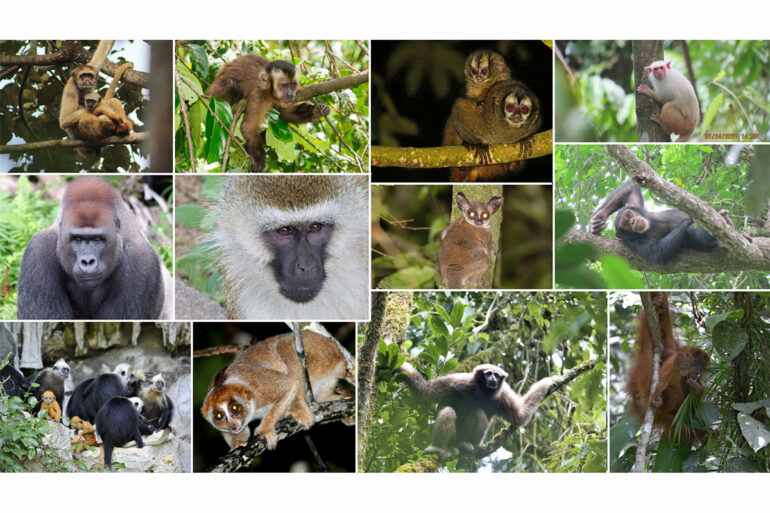By comparing geographic patterns of nonhuman primate biodiversity and human land-use, researchers discovered that areas managed or controlled by Indigenous peoples tend to have significantly more primate biodiversity than nearby regions. They also found that lorises, tarsiers, monkeys and apes whose territories overlap with Indigenous areas are less likely to be classified as vulnerable, threatened or endangered than those living fully outside Indigenous lands.
The findings are reported in the journal Science Advances.
“There is an impending extinction crisis among the world’s 521 primate species,” said Paul A. Garber, a professor emeritus of anthropology at the University of Illinois Urbana-Champaign who led the research with Alejandro Estrada, a professor in the Institute of Biology at the National Autonomous University of Mexico. “We know that 68% of these species are vulnerable, endangered or critically endangered and many of them may not survive to the end of the century. Worldwide, 93% of primate populations are declining.”
Understanding the conditions that allow primate populations to survive and even thrive is critical to preventing their extinction and preserving their special contributions to healthy forest ecosystems, Garber said.
“Most primates exploit forests, where they serve as agents of pollination and seed dispersal,” he said. “They’re involved in important predator-prey relationships. They consume insects and small vertebrates. They play a very important role in the regeneration of forests.”
Because they are relatively large-bodied animals with a slow reproductive rate and a late age of first reproduction, primates also are “one of the first indicator species if there’s some perturbation or dramatic change in the environment,” he said.
For the study, the researchers reviewed scientific reports of Indigenous peoples and primate biodiversity, and conducted a spatial analysis “to assess the significance of Indigenous peoples’ lands in safeguarding primate biodiversity,” the authors wrote. “We found that Indigenous peoples’ lands account for 30% of the primate range, and 71% of primate species inhabit these lands. As their range on these lands increases, primate species are less likely to be classified as threatened or have declining populations.”
The pattern held true even when comparing Indigenous lands to regions with roughly the same human population density immediately outside these Indigenous territories, and 10, 25 and 50 kilometers from their borders.
“The results were that the human footprint—a measure of infrastructure development and habitat conversion—was significantly greater immediately outside Indigenous peoples’ lands than inside,” Garber said.
Most Indigenous groups whose territories overlap with those of nonhuman primates have an ancient association with their lands and these animals, and many—though not all—have developed cultural practices and norms that aid in preserving primate populations and ecosystem health, Garber said.
“There are many different Indigenous peoples, and they exploit their environments in different and multifaceted ways,” he said. “While many groups hunt primates, they also hunt pigs, ungulates, rodents, birds and fish. They gather forest resources including medicinal plants. They have gardens, employ methods of shifting cultivation and engage in herding.”
This reduces their reliance on primates as a primary food source.
Many Indigenous groups also engage in practices that preserve primate habitat and reproductive capacity, he said. Some hunt only within a 10- or 15-kilometer radius of their villages and consider more distant lands sacred landscapes. This allows primates further away to increase their numbers and move into areas closer to the villages as those zones experience population declines as a result of hunting.
“In addition, Indigenous groups have various prohibitions based on their knowledge, culture or religion,” Garber said. “We cite several cases, for example, where a species of primate may only be hunted for a particular festival. Or a particular primate species is not hunted when fruit is overabundant in the forest, allowing those populations to get into reproductive condition and produce offspring.”
There are exceptions to the close association between Indigenous peoples’ lands and primate biodiversity, Garber said. But most exceptions appear to be the result of colonial practices in recent centuries. For example, in east Africa, large swaths of traditional Indigenous lands were taken away from Indigenous communities and preserved as national parks, where primate biodiversity remains higher than in the cattle-grazing areas that many Indigenous peoples continue to inhabit.
In Madagascar, a country that hosts more than 100 primate species, no groups meet internationally accepted definitions of Indigenous peoples, and none identify as Indigenous, the researchers report. A former French colony, Madagascar has lost about 90% of its original forest. Roughly 96% of its primate species, all of which are lemurs, are listed by the International Union for Conservation of Nature as threatened (vulnerable, endangered or critically endangered).
The study is correlational and therefore does not provide direct evidence that Indigenous practices account for the higher diversity of primate species on those lands. But it strongly suggests that “safeguarding Indigenous peoples’ lands, languages and cultures represents our greatest chance to prevent the extinction of the world’s primates,” the authors wrote.
The paper is title “Global importance of Indigenous peoples, their lands, and knowledge systems for saving the world’s primates from extinction.”
More information:
Alejandro Estrada et al, Global importance of Indigenous Peoples, their lands, and knowledge systems for saving the world’s primates from extinction, Science Advances (2022). DOI: 10.1126/sciadv.abn2927. www.science.org/doi/10.1126/sciadv.abn2927
Provided by
University of Illinois at Urbana-Champaign
Citation:
Study links protecting Indigenous peoples’ lands to greater nonhuman primate biodiversity (2022, August 10)
